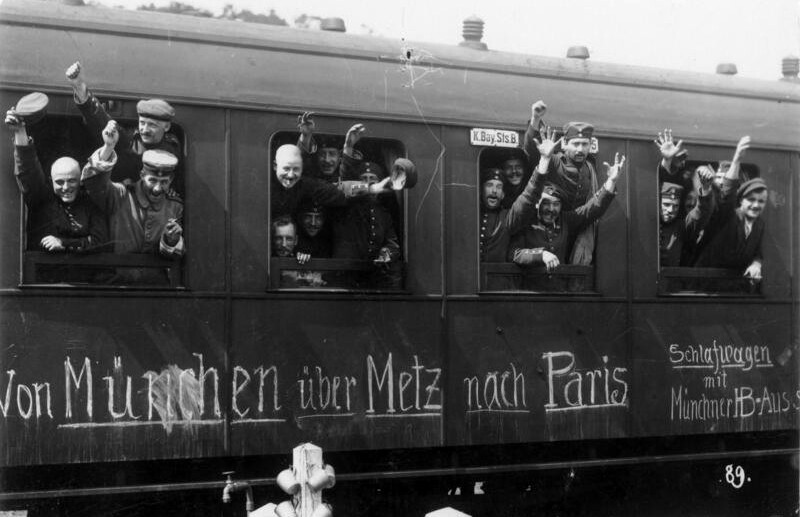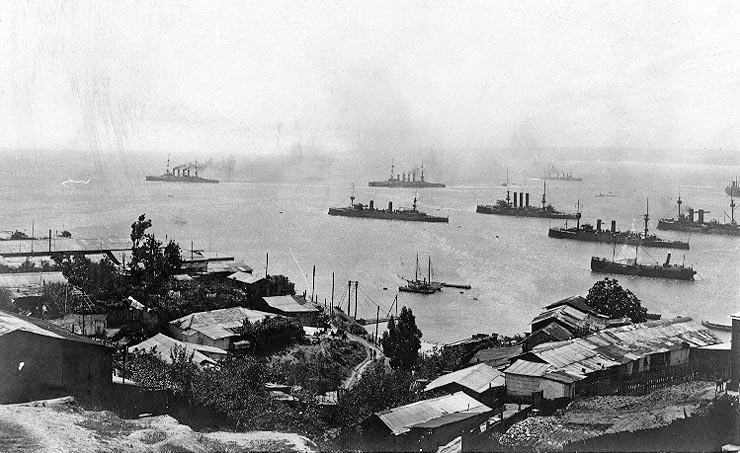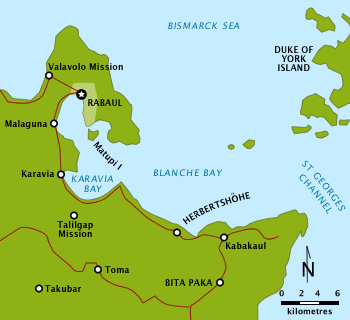|
Siege Of Toma
The siege of Toma was a bloodless action during the First World War on the island of New Pomerania (now New Britain) between 14 and 17 September 1914 as part of the occupation of German New Guinea by the Australian Naval and Military Expeditionary Force (AN&MEF). Australian forces had been dispatched to seize and destroy German wireless stations in the south-west Pacific because they were used by the German East Asian Cruiser Squadron of Vice-Admiral Maximilian von Spee which threatened merchant shipping in the region. New Zealand provided a similar force for the occupation of German Samoa. Ultimately the German colonial government was forced to surrender after being surrounded, ending the last significant resistance in the territory. Prelude The Australian Naval and Military Expeditionary Force (AN&MEF) reached Rabaul on 11 September, finding the port free of German forces. Small parties of naval reservists landed at Kabakaul and Herbertshöhe on Neu-Pommern, south-east of Ra ... [...More Info...] [...Related Items...] OR: [Wikipedia] [Google] [Baidu] |
Australian Occupation Of German New Guinea
The Australian occupation of German New Guinea was the takeover of the Pacific colony of German New Guinea in September – November 1914 by an expeditionary force from Australia, called the Australian Naval and Military Expeditionary Force. Background German New Guinea German New Guinea (german: Deutsch-Neuguinea) was an Imperial German protectorate from 1884. German New Guinea consisted of the territories of the northeastern part of New Guinea (german: Kaiser-Wilhelmsland) and the nearby Bismarck Archipelago, consisting of New Britain (german: Neu-Pommern) and New Ireland (german: Neu-Mecklenburg). Together with the other Western Pacific German islands, excluding German Samoa, they formed the Imperial German Pacific Protectorates. The protectorate included the German Solomon Islands, the Caroline Islands, Palau, the Mariana Islands (except for Guam), the Marshall Islands and Nauru. Imperial Germany had a paramilitary police force, the ''Polizeitruppe'', in New Guinea; gen ... [...More Info...] [...Related Items...] OR: [Wikipedia] [Google] [Baidu] |
Maximilian Von Spee
Maximilian Johannes Maria Hubert Reichsgraf von Spee (22 June 1861 – 8 December 1914) was a naval officer of the German '' Kaiserliche Marine'' (Imperial Navy), who commanded the East Asia Squadron during World War I. Spee entered the navy in 1878 and served in a variety of roles and locations, including on a colonial gunboat in German West Africa in the 1880s, the East Africa Squadron in the late 1890s, and as commander of several warships in the main German fleet in the early 1900s. During his time in Germany in the late 1880s and early 1890s, he married his wife, Margareta, and had three children, his sons Heinrich and Otto and his daughter Huberta. By 1912, he had returned to the East Asia Squadron as its commander, and was promoted to the rank of '' Vizeadmiral'' (Vice Admiral) the following year. After the outbreak of World War I in July 1914, Spee led his squadron across the Pacific to the coast of South America. Here on 1 November, he defeated the British 4th Cruise ... [...More Info...] [...Related Items...] OR: [Wikipedia] [Google] [Baidu] |
1914 In Papua New Guinea
This year saw the beginning of what became known as World War I, after Archduke Franz Ferdinand of Austria, heir to the Austrian throne was assassinated by Serbian nationalist Gavrilo Princip. It also saw the first airline to provide scheduled regular commercial passenger services with heavier-than-air aircraft, with the St. Petersburg–Tampa Airboat Line. Events January * January 1 – The St. Petersburg–Tampa Airboat Line in the United States starts services between St. Petersburg and Tampa, Florida, becoming the first airline to provide scheduled regular commercial passenger services with heavier-than-air aircraft, with Tony Jannus (the first federally-licensed pilot) conveying passengers in a Benoist XIV flying boat. Abram C. Pheil, mayor of St. Petersburg, is the first airline passenger, and over 3,000 people witness the first departure. * January 11 – The Sakurajima volcano in Japan begins to erupt, becoming effusive after a very large earthquake ... [...More Info...] [...Related Items...] OR: [Wikipedia] [Google] [Baidu] |
1914 In German New Guinea
This year saw the beginning of what became known as World War I, after Archduke Franz Ferdinand of Austria, heir to the Austrian throne was assassinated by Serbian nationalist Gavrilo Princip. It also saw the first airline to provide scheduled regular commercial passenger services with heavier-than-air aircraft, with the St. Petersburg–Tampa Airboat Line. Events January * January 1 – The St. Petersburg–Tampa Airboat Line in the United States starts services between St. Petersburg and Tampa, Florida, becoming the first airline to provide scheduled regular commercial passenger services with heavier-than-air aircraft, with Tony Jannus (the first federally-licensed pilot) conveying passengers in a Benoist XIV flying boat. Abram C. Pheil, mayor of St. Petersburg, is the first airline passenger, and over 3,000 people witness the first departure. * January 11 – The Sakurajima volcano in Japan begins to erupt, becoming effusive after a very large earthq ... [...More Info...] [...Related Items...] OR: [Wikipedia] [Google] [Baidu] |
Conflicts In 1914
Conflict may refer to: Arts, entertainment, and media Films * ''Conflict'' (1921 film), an American silent film directed by Stuart Paton * ''Conflict'' (1936 film), an American boxing film starring John Wayne * ''Conflict'' (1937 film), a Swedish drama film directed by Per-Axel Branner * ''Conflict'' (1938 film), a French drama film directed by Léonide Moguy * ''Conflict'' (1945 film), an American suspense film starring Humphrey Bogart * ''Catholics: A Fable'' (1973 film), or ''The Conflict'', a film starring Martin Sheen * ''Judith'' (1966 film) or ''Conflict'', a film starring Sophia Loren * ''Samar'' (1999 film) or ''Conflict'', a 1999 Indian film by Shyam Benegal Games * ''Conflict'' (series), a 2002–2008 series of war games for the PS2, Xbox, and PC * ''Conflict'' (video game), a 1989 Nintendo Entertainment System war game * '' Conflict: Middle East Political Simulator'', a 1990 strategy computer game Literature and periodicals * ''Conflict'' (novel ... [...More Info...] [...Related Items...] OR: [Wikipedia] [Google] [Baidu] |
Military History Of Australia During World War I
In Australia, the outbreak of World War I was greeted with considerable enthusiasm. Even before Britain declared war on Germany on 4 August 1914, the nation pledged its support alongside other states of the British Empire and almost immediately began preparations to send forces overseas to engage in the conflict. The first campaign that Australians were involved in was in German New Guinea after a hastily raised force known as the Australian Naval and Military Expeditionary Force was dispatched in September 1914 from Australia and seized and held German possessions in the Pacific. At the same time another expeditionary force, initially consisting of 20,000 men and known as the First Australian Imperial Force (AIF), was raised for service overseas. The AIF departed Australia in November 1914 and, after several delays due to the presence of German naval vessels in the Indian Ocean, arrived in Egypt, where they were initially used to defend the Suez Canal. In early 1915, however ... [...More Info...] [...Related Items...] OR: [Wikipedia] [Google] [Baidu] |
Hermann Detzner
Hermann Philipp Detzner (16 October 1882 – 1 December 1970) was a German engineer and surveyor, who served as an officer in the German colonial security force (''Schutztruppe'') in ''Kamerun'' (Cameroon) and German New Guinea. He gained fame for evading capture after Australian troops invaded German New Guinea at the start of World War I. In early 1914, the German government sent Detzner to explore and chart central Kaiser-Wilhelmsland, the imperial protectorate on the island of New Guinea. When World War I broke out in Europe, he was far from civilisation and without radio contact. He refused to surrender to Australian Naval and Military Expeditionary Force, Australian troops when they occupied German New Guinea, concealing himself in the jungle with a band of approximately 20 soldiers. For four years, Detzner and his troops provocatively marched through the bush, singing "Die Wacht am Rhein, Watch on the Rhine" and flying the German Imperial flag. He led at least one expe ... [...More Info...] [...Related Items...] OR: [Wikipedia] [Google] [Baidu] |
Oath
Traditionally an oath (from Anglo-Saxon ', also called plight) is either a statement of fact or a promise taken by a sacrality as a sign of verity. A common legal substitute for those who conscientiously object to making sacred oaths is to give an affirmation instead. Nowadays, even when there is no notion of sanctity involved, certain promises said out loud in ceremonial or juridical purpose are referred to as oaths. "To swear" is a verb used to describe the taking of an oath, to making a solemn vow. Etymology The word come from Anglo-Saxon ' judicial swearing, solemn appeal to deity in witness of truth or a promise," from Proto-Germanic '' *aiþaz'' (source also of Old Norse eiðr, Swedish ed, Old Saxon, Old Frisian eth, Middle Dutch eet, Dutch eed, German Eid, Gothic aiþs "oath"), from PIE *oi-to- "an oath" (source also of Old Irish oeth "oath"). Common to Celtic and Germanic, possibly a loan-word from one to the other, but the history is obscure and it may ultimately ... [...More Info...] [...Related Items...] OR: [Wikipedia] [Google] [Baidu] |
German East Asia Squadron
The German East Asia Squadron (german: Kreuzergeschwader / Ostasiengeschwader) was an Imperial German Navy cruiser squadron which operated mainly in the Pacific Ocean between the mid-1890s until 1914, when it was destroyed at the Battle of the Falkland Islands. It was based at Germany's Kiautschou Bay concession in China. Background The Treaty of Peking of September 1861 between the Kingdom of Prussia and China allowed Prussian warships to operate in Chinese waters. As East Asia grew in economic and political importance to the recently united Germany, in 1881 a flying squadron was formed for the area under the command of a flag officer. Since African colonies were then seen as of greater value, an African Cruiser Squadron was established in 1885 with permanent status, and shortly thereafter the Imperial German Navy reduced the East Asia presence to two small gunboats. From 1888 to 1892, was flagship of the German East Asia Squadron, initially under vice-admiral Karl August Dei ... [...More Info...] [...Related Items...] OR: [Wikipedia] [Google] [Baidu] |
Battle Of Bita Paka
The Battle of Bita Paka (11 September 1914) was fought south of Kabakaul, on the island of New Britain, and was a part of the invasion and subsequent occupation of German New Guinea by the Australian Naval and Military Expeditionary Force (AN&MEF) shortly after the outbreak of the First World War. Similar to New Zealand's operation against German Samoa in August, the main target of the operation was a strategically important wireless station—one of several used by the German East Asiatic Squadron—which the Australians believed to be located in the area. The powerful German naval fleet threatened British interests and its elimination was an early priority of the British and Australian governments during the war. After an unopposed landing, a mixed force of German reservists and half-trained Melanesian police mounted a stout resistance and forced the Australians to fight their way to the objective. After a day of fighting during which both sides suffered casualties, Aust ... [...More Info...] [...Related Items...] OR: [Wikipedia] [Google] [Baidu] |
Neu-Pommern
New Britain ( tpi, Niu Briten) is the largest island in the Bismarck Archipelago, part of the Islands Region of Papua New Guinea. It is separated from New Guinea by a northwest corner of the Solomon Sea (or with an island hop of Umboi the Dampier and Vitiaz Straits) and from New Ireland by St. George's Channel. The main towns of New Britain are Rabaul/ Kokopo and Kimbe. The island is roughly the size of Taiwan. While the island was part of German New Guinea, it was named Neupommern ("New Pomerania"). In common with most of the Bismarcks it was largely formed by volcanic processes, and has active volcanoes including Ulawun (highest volcano nationally), Langila, the Garbuna Group, the Sulu Range, and the volcanoes Tavurvur and Vulcan of the Rabaul caldera. A major eruption of Tavurvur in 1994 destroyed the East New Britain provincial capital of Rabaul. Most of the town still lies under metres of ash, and the capital has been moved to nearby Kokopo. Geography New Br ... [...More Info...] [...Related Items...] OR: [Wikipedia] [Google] [Baidu] |
Herbertshöhe
Kokopo is the capital of East New Britain Province in Papua New Guinea. It is administered under Kokopo-Vunamami Urban LLG. The capital was moved from Rabaul in 1994 when the volcanoes Tavurvur and Vulcan erupted. As a result, the population of the town increased more than sixfold from 3,150 in 1990 to 20,262 in 2000. Kokopo was known as Herbertshöhe (''Herbert's Heights''), named in honour of Herbert, eldest son of German Chancellor Otto von Bismarck, during the German New Guinea administration, which controlled the area between 1884 and formally until 1919. Until 1910, it was the capital of German New Guinea. On Sunday, March 29, 2015, a strong earthquake, of a preliminary magnitude of at least 7.5, which at that time was the largest earthquake of 2015, was recorded near Kokopo, and a tsunami warning was issued. This was surpassed a month later by the April 2015 Nepal earthquake, which measured a magnitude 7.8. In 2015, a research and conservation project was suggested to stu ... [...More Info...] [...Related Items...] OR: [Wikipedia] [Google] [Baidu] |




.png)



